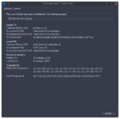Transport Layer Security facts for kids
Transport Layer Security (TLS) and its older version, Secure Sockets Layer (SSL), are like secret codes for the internet. They help keep your online messages safe and private when you use websites, send emails, or chat with friends. These codes make sure no one can secretly listen in, change your messages, or pretend to be someone else online.
Contents
How TLS Keeps You Safe
TLS makes sure that when your computer talks to a website, their conversation is private. It's like sending a message in a locked box. Only the right person with the key can open and read it. This stops people from eavesdropping (listening in), tampering (changing messages), or forging (making fake messages).
Most of the time, TLS checks that the website you are visiting is real. This means you can be sure you are talking to the correct website, like your bank's website, and not a fake one. Sometimes, it can also check if your computer is real, which adds even more security.
Where TLS is Used
You use TLS and SSL all the time, even if you don't know it! They are used in many common apps and programs:
- Web browsing: When you see "https://" in a website address, it means TLS is protecting your connection.
- Email: Sending and receiving emails often uses TLS to keep them private.
- Instant messaging: Your chats can be kept secret with TLS.
- Voice calls over the internet (VoIP): Like when you use apps to make calls, TLS helps secure your voice.
Many computer programmers use special tools like OpenSSL or NSS to add TLS security to their own software.
Different Versions of TLS
Just like apps get updates, TLS has different versions. The newest and safest version is 1.2. Older versions like 1.0 and 1.1 are still around but are not as secure. New updates often add more ways to keep your information safe online.
Related Topics
- Certificate authority: These are like trusted ID card makers for websites.
- Public key certificate: This is the digital ID card a website shows to prove it's real.
- Datagram Transport Layer Security: A special type of TLS for faster, but less reliable, connections.
- Virtual private network: A way to create a secure connection over a public network, often using TLS.
Software That Uses TLS
Many important software tools use TLS to keep things secure:
- OpenSSL: A very popular and free tool that many programs use for TLS.
- GnuTLS: Another free tool for adding TLS security.
- JSSE: A tool for Java programs to use TLS.
- Network Security Services (NSS): An open-source library used by many applications, including web browsers.
Images for kids
See also
 In Spanish: Seguridad de la capa de transporte para niños
In Spanish: Seguridad de la capa de transporte para niños


